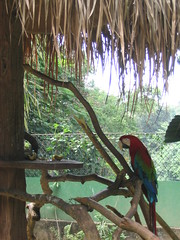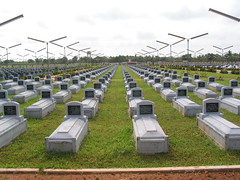Colombo Zoo
Click above to view photos from the Colombo Zoo, in Colombo, Sri Lanka
The zoo was pretty large, well laid out and had a wide variety of animals. I liked how the concrete/artificial aspects seemed minimal, i'm not sure if this was done on purpose but the abundance of vegetation gave it a less 'artificial' feel than some western zoos. There weren't many people there the day we went but that might have been because of the bad weather.
Zoos in the west have tried to move away from their traditional role - exhibiting exotic animals for public entertainment. Now they're more focused on things like education, research, repopulation and conservation. As far as I could tell, the Colombo Zoo wasn't that interested in education; most exhibits had species' names but nothing beyond that. I can't speak to their research or conservation activities but there wasn't any mention of that anywhere.
The facilities for the animals ranged in quality: the sloth bear and the chimps had large, open 'habitats'. The big cats were all crammed into small cages and they looked overweight and bored. The asian elephants are the most popular draw at the zoo, they have a structure built in a central location where people sat and watched them. I'm not sure why we sat and watched them, they weren't doing what elephants do in the wild. They were chained to columns and stood in place swaying from side to side. Once a day they're taken for a walk. The conditions of the elephants could stand to improve a great deal.
Anyways, the Zoo is a good place to spend half a day when you're in Colombo. I wish I had gone on one of the wildlife tours that are available in Sri Lanka. The island has a vast amount of diverse wildlife and I think I would have preferred to see it in the wild.
The zoo was pretty large, well laid out and had a wide variety of animals. I liked how the concrete/artificial aspects seemed minimal, i'm not sure if this was done on purpose but the abundance of vegetation gave it a less 'artificial' feel than some western zoos. There weren't many people there the day we went but that might have been because of the bad weather.
Zoos in the west have tried to move away from their traditional role - exhibiting exotic animals for public entertainment. Now they're more focused on things like education, research, repopulation and conservation. As far as I could tell, the Colombo Zoo wasn't that interested in education; most exhibits had species' names but nothing beyond that. I can't speak to their research or conservation activities but there wasn't any mention of that anywhere.
The facilities for the animals ranged in quality: the sloth bear and the chimps had large, open 'habitats'. The big cats were all crammed into small cages and they looked overweight and bored. The asian elephants are the most popular draw at the zoo, they have a structure built in a central location where people sat and watched them. I'm not sure why we sat and watched them, they weren't doing what elephants do in the wild. They were chained to columns and stood in place swaying from side to side. Once a day they're taken for a walk. The conditions of the elephants could stand to improve a great deal.
Anyways, the Zoo is a good place to spend half a day when you're in Colombo. I wish I had gone on one of the wildlife tours that are available in Sri Lanka. The island has a vast amount of diverse wildlife and I think I would have preferred to see it in the wild.



